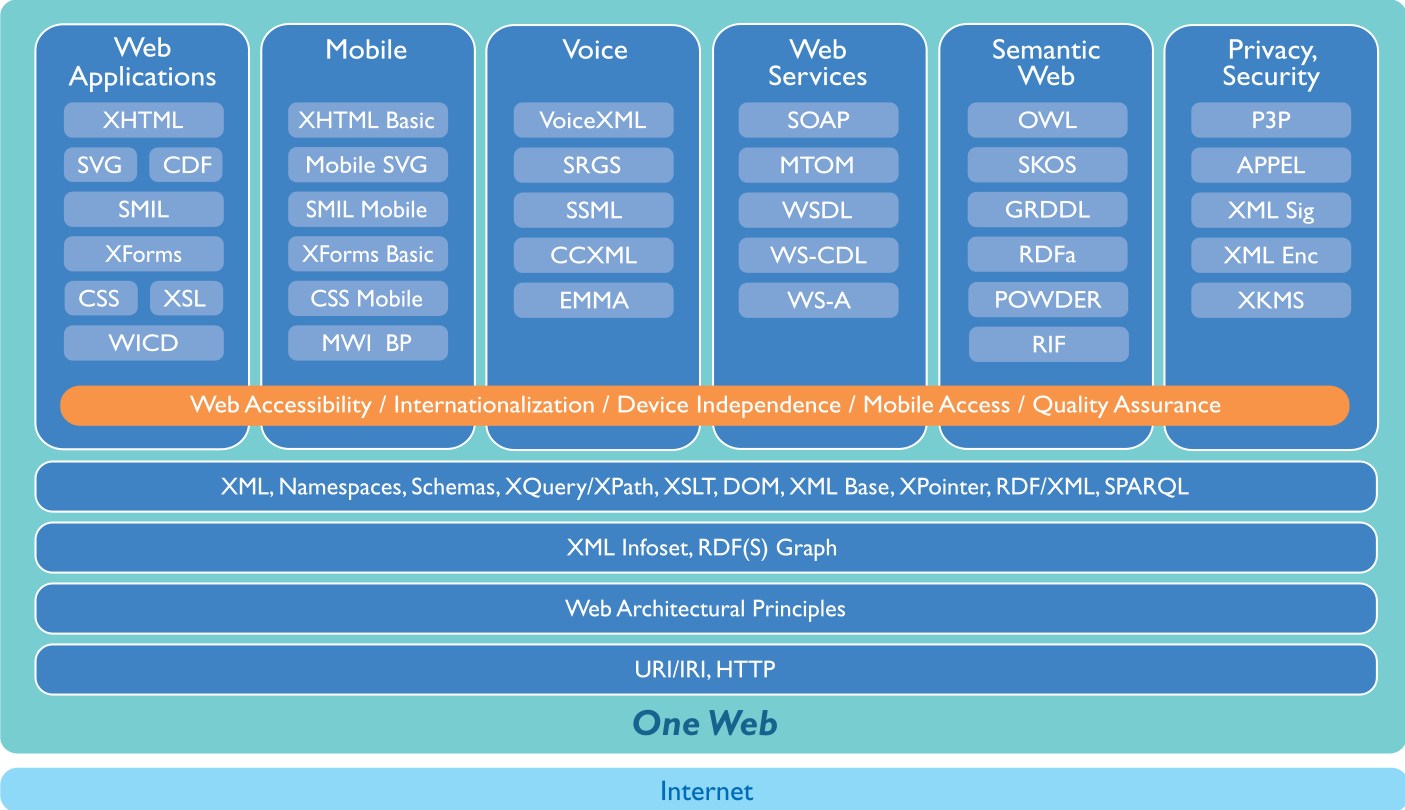Content
I'm trying to give you an idea of:
The Web
After ~17 years in the wild the Web has changed and still develops in various directions:
- Web everywhere – the Mobile Web
- Web for everyone – the Accessible Web
- Web of structured information – the Semantic Web
- Web of participation and communication – Collections, Blogs and Fora
- Web as a service – Rich Web Applications
- Web for business – Web Services
- Web for media – Video and Voice on the web
Admitted: there might be different views on this
Requirements for the Web
Some general demands in order to make the Web useful and successful:
- privacy on the Web
- security and trust on the Web
- treatment of intellectual property
- content classification and rating
- accessibility of the Web
- scalability of the Web
It started pretty simple
- a common syntax for documents that may contain hyperlinks (HTML)
- provides a base for structuring documents
- a framework for applications to display document
- a mechanism to link to other documents
- a syntax for locating documents (or fragments of documents) and the option to use this syntax within HTML to build hyperlinks (URL)
- a base for a globally unique identification of documents
- unique identification it relies on the Internet Domain Name System
- a protocol to send request and responses between clients (usually browsers) and servers (HTTP)
- to make servers and clients understand each other
Fairly simple, but most of the topics mentioned before where not yet addressed - except: it scaled!
Broadening the Basis
- URL concept extended to URI and IRI
- a more general scheme for uniquely naming documents, real objects and beings, abstract concepts and ideas ...
- HTML as basis is replaced by a more general concept: XML
- document structuring tags, can be freely chosen
- can represent hierarchical databases
- (apart from some syntactic restrictions of XML) HTML can be seen as a "restricted XML"
- XHTML resolves this syntax problem
- A few supporting technologies came with XML as there are:
- XML name spaces as a means to separate one space of tags from another
- XML Schemas to allow the definition of restrictions to specify a new XML language
- XQuery/Xpath as a means to navigate through or query XML documents
- XML Base to cope with relative URIs/IRIs
- XPointer to allow reference to XML documents and fragments
- the DOM an abstract Interface to process XML and related events
Even broader ...
- XML relies on the concept to define complex entities by composing them of simpler ones.
- RDF graphs try to define entities by describing their relationship to others.
- An RDF graph is composed of triples of the form subject predicate object

- subject (a resource) denotes something you want to define, predicate defines the relationship (property), and object (a resource) is something for which the relationship holds
- Objects (and even predicates) in one triple can appear as subjects in others
- As XML RDF comes with a set of associated technologies
- RDFS is a Schema language that defines a vocabulary that gives meaning to some resources and properties. This opens a standardized way to express set or logic related properties. OWL supplements and extents these definitions.
- SPARQL is a query language for RDF
The universal Web
- everybody should be able to use the Web with a wide range of devices in any language he knows according to his mental capabilities
- accessibility
- device independence
- internationalization
- general rules that help to achieve this:
- use standards wherever they exist
- add redundancy in the way you present your information
- structure your information properly, present it recognizable
- separate content from presentation
- welcome side effects:
- a Web site that is accessible is usually better searchable
- usability and accessibility go hand in hand
- these rules also contribute to maintainability
Web applications
- plain HTML is all you need to build a Web application
- on the other end we see fully fledged applications for:
- office work or picture processing.
- Video, audio
- sophisticated graphics
- presentational software for mathematics or chemistry
- Plugins and Interpreters for programming languages allow nearly any content or processing that works on the desktop. Using technologies that are
- standardized
- proprietary
- Open Source
- locked
- some important standards
- HTML ... 2 are emerging actually
- the main focus of XHTML 2 is to better use the advantages of XML within HTML
- HTML 5 is more on advancing the existing HTML (HTML 4 or XHTML 1) in a compatible way
- CSS to control presentation in a structured way
- Xforms as a better way to exchange information with servers
- SVG for vector based two dimensional graphics
- compound document standards (WICD, CDF…) to allow better integration of parts of a document using different technologies
- The Web – especially when combined with powerful programming languages and interfaces – can act as a platform for sophisticated applications.
- Games, maps, image processing or complete office suites…
- using technologies like Compound Document Formats, XML, the DOM (and DOM events), Xforms, XHTML, SVG and some more
- SMIL to build presentations with media from various sources in a synchronized manner
The web today
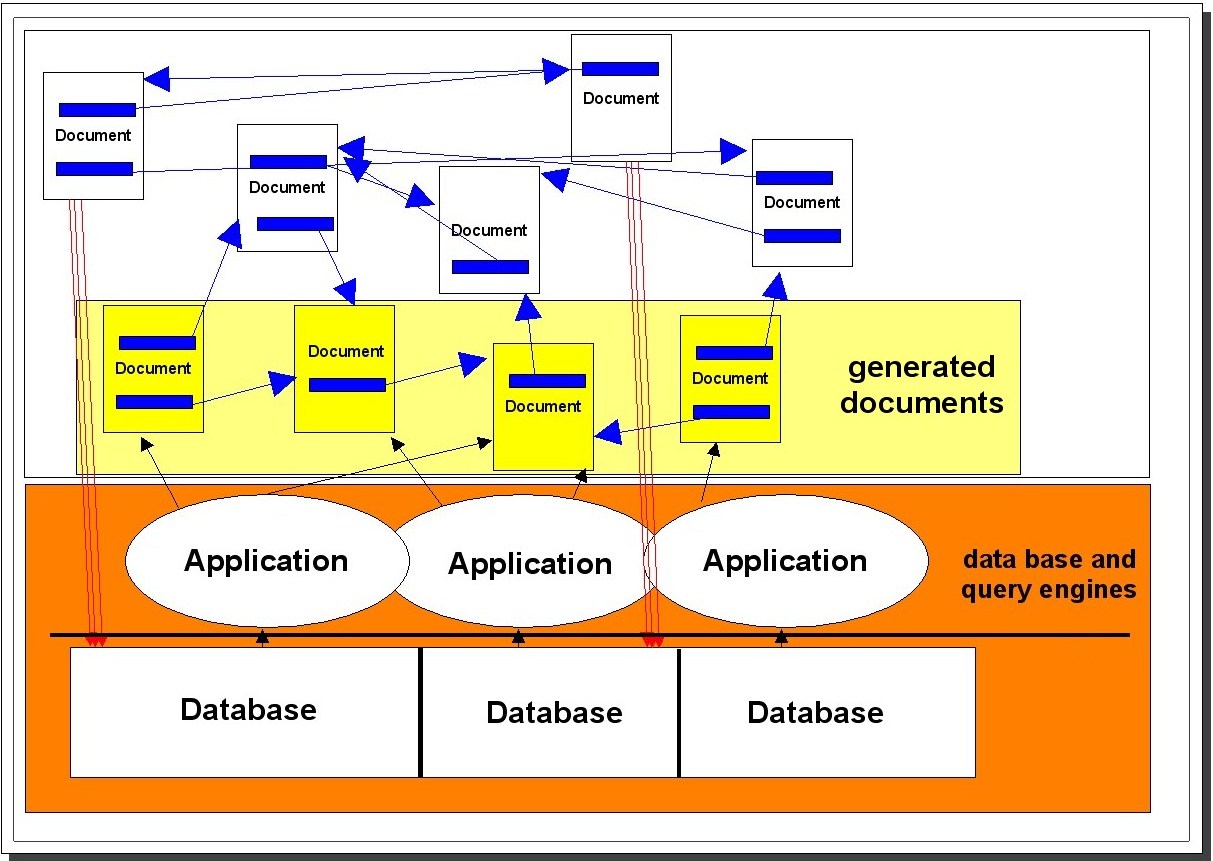
Semantic Web
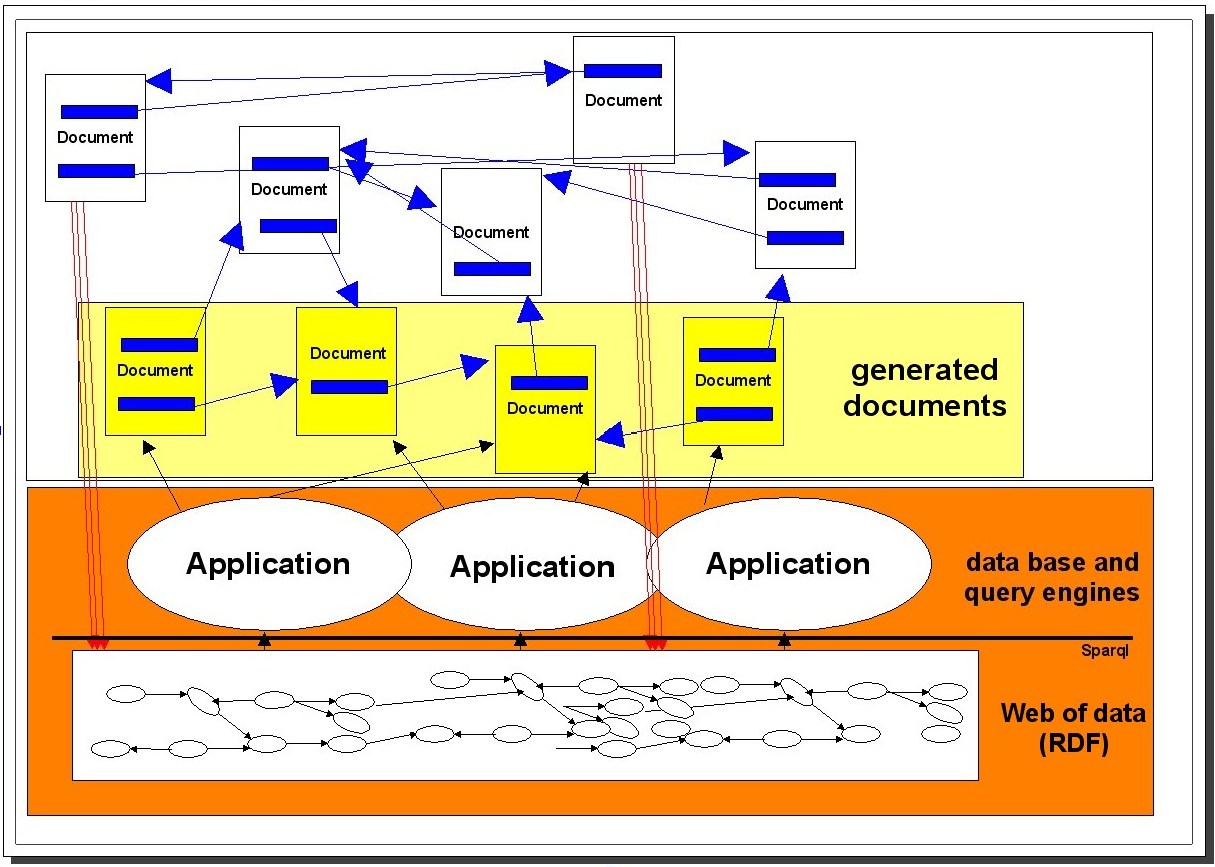
How do we get there
- Stop: Mash-ups/Ajax do it already!
- API based, often one API per source
- APIs mostly proprietary
- quite some effort in implementing
- dependency from API provider
- instrumental to show how powerful a Web of data can be
- Microformats:
- standard to represent data
- could be used by mash-up
- not very flexible, rather static
- standards to resolve this:
- RDF family (RDFS, OWL) to represent data
- SPARQL to access data
- RDFa allows to include RDF statements in an XHTML document
- SKOS provides a data model for sharing and linking knowledge organization systems as application of RDF
- Linking Open Data gives an impressive example of how data can be linked
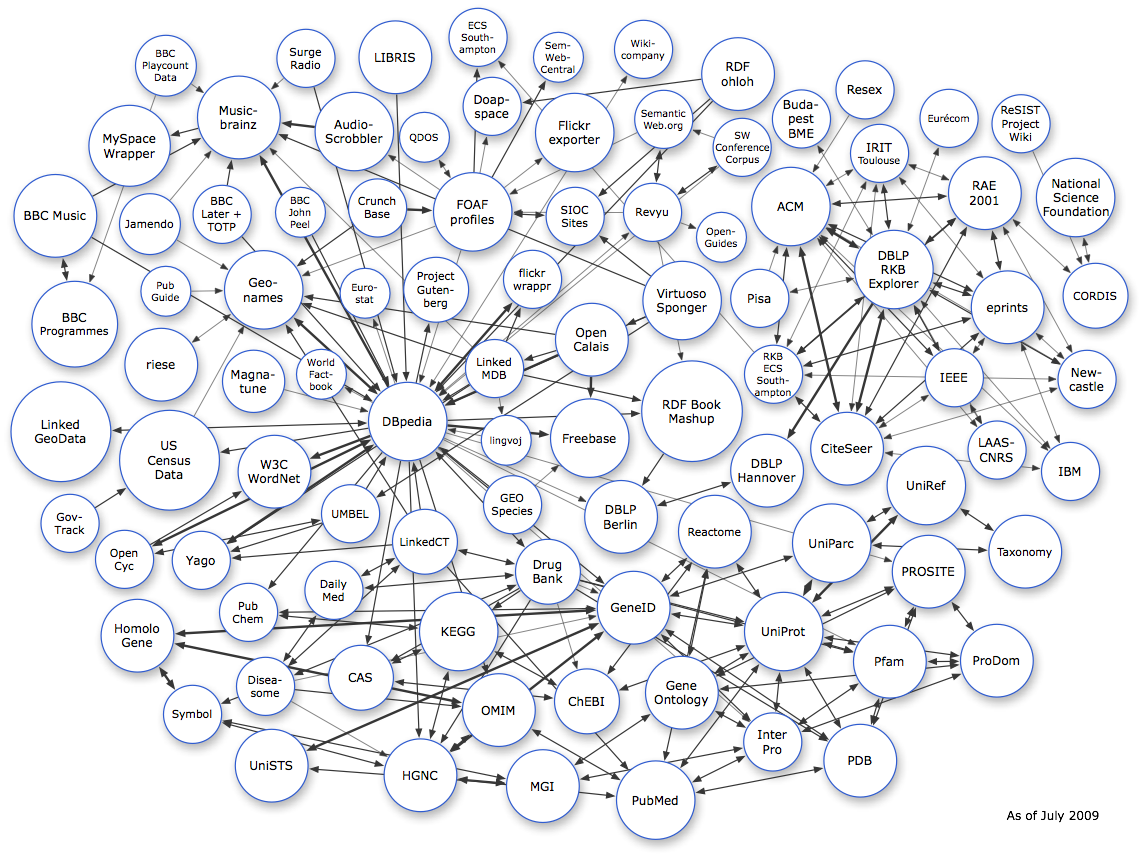
Web Services
- Web Services is not about browsing
- interoperation of software applications that run on computers interconnected by a network
- especially in e-business
- pass data from one business step to the next ones
- automate parts of the business process
- lot of concepts and buzzwords (EAI, ESB, MOM, SOA…)
- technologies
- SOAP specifies the format of messages that can be used to communicate with a service
- WS-Addressing describes how to address Web Services and messages
- WSDL is a language to describe a service by the kind of messages it will receive or send and its functionality. There is also a standard for Semantic Annotations to WSDL (SAWSDL) which allows to use ontologies to deceive the semantics of Web Services.
- a means to specify policies for the use of a service can be specified and attached to a service by using the Web Services Policy specifications.
- Semantic Annotations for WSDL allow to include semantics into service descriptions
Mobile Web
- devices with limited capabilities (e.g. mobile phones)
- connectivity
- bandwidth
- processing power
- display size and sound quality
- limited capabilities are addressed by
- down sizing of existing standards to match the constraints of mobile devices
- the development of guidelines especially for authors (but for authoring-tool manufacturers as well) on how to make sure that a Web site is mobile friendly
- a way for servers to learn about the capabilities of an attached client
- technologies:
- downsized standards XHTML Basic, SVG Tiny, SVG Basic,, SMIL mobile, Xforms Basic and CSS mobile
- DDR simple API describes an interface that servers can use to query device description
Voice: the phone on the Web
- designing voice dialogs
- VoiceXML is about defining frameworks for dialogs.
- speach oriented standards to support the use of VoiceXML:
- The SSML is an XML based language to assist the generation of synthetic speech.
- SRGS allows the specification of grammars for recognition of speech.
- CCXML provides support for telephony call control and can be used in conjunction with dialog systems such as VoiceXML.
- EMMA is an XML language to describe input received on several channels (voice, handwriting, keyboard…) simultaneously.
Privacy and security
- issues
- while using the Web we disclose a lot of our personal data, our interests and preferences
- can we be sure that the Web site that pretends to be the home page of our bank is really our bank?
- can we securely transfer confidential data over the Web?
- can we securely identify ourselves on the web?
- technologie that help
- P3P is a standard for specifying a machine readable description of a privacy policy
- TLS/SSL resolves much of the authentication, authorithation, confidentiallity issues on the Internet transport layer
- XML Encryption, XML Signature and XML Key Management: 3 related technologies that allow to apply well known cryptographic methods on fragments of XML documents
The Web live
- here we are and ...
- technologies and standards are a means to an end
- the list is far from complete
- available bandwidth and compute power are steadily increasing
- Web turned from geek's toy to a powerful infrastructure
- formed by millions of individuals, business people, journalists, artists, scientists…
- Google, Yahoo, Flickr, Ebay, Youtube, Myspace, Wikipedia, Mozilla are only a few popular projects that live in this one space
- here we go
- a lot of open questions that wait for ideas, technical solutions, standards or a social agreement
- in parallel to the work on millions of Web sites, Blogs, Wikis, shops and fancy applications there is ongoing work on better standards and technologies
- W3C provides a framework where vendors, authors and users cooperate to improve the supporting frame of the Web
W3C Structure
- process document http://www.w3.org/Consortium/Process/ holds details
- Director (Tim Berners-Lee)
- general lead, stating consensus according to process
- names a portion of the TAG
- CEO (Ralph Swick, acting) W3C business
- Team (~55 employed or subcontracted individuals) management of W3C work, WG contacts
- 18 Offices, regional partners and representatives around the World, Beijing: Beihang University
- Members constitute W3C
- each member names an Acvisory Committee Representative (AC-rep)
- AC-reps vote on behalf of their organization
- AC meets twice a year
- AC elects the Advisory Board (esp. concerned with the process)
- AC elects a portion of the Technical Architecture Group (esp. concerned with the overall architecture)
- AC votes on activities, standards and other relevant issues
- AC-reps name their participants in Groups
W3C Groups
- chartered, AC vote
- team contact
- chair
- mailing list(s)
- Working Groups (WG)
- Interest Group (IG)
- Coordonation Group (CG)
- manages dependencies and facilitates communication with other groups
- each member can launch an Incubator Group (XG) with less requirements
- research and evaluation of ideas
- not part of the process (yet)
Outline of the W3C patent policy
- Goal: Produce Recommendations implementable on Royalty-Free basis and allow technical work to with minimal interruption
- W3C RF obligations for Working Group participants
- W3C Royalty-Free licensing definition
- Disclosure rules
- Exception Handling: Patent Advisory Group (PAG)
- Royalty-Free Licensing Commitment
- All Working Group Participants must agree to license Essential Claims they hold on an RF basis
- ONLY Essential Claims - target is interoperability
- Exclusions possible early in the development of a specification
- Disclosure
- Must disclose if you have actual knowledge
- WG Participants don't have to disclose UNLESS they seek to exclude a patent from the licensing obligation
Some simple rules - great impact
- everything is on the web
- if its not on the Web it does not exist!
- paperless
- history - archiving and versioning by CVS!
- proof of concept
- gives us feedback (about use)
- eat your own dogfood!
- use standards for your work wherever you can
- be your own usecase
- store your ideas on the server - there you can refer to them
- conform to standards - no cheap excuses please!
- document your communication - use mailinglists and logged IRC
- be open to new applications of standards
- RSS feeds
- WIKIs
- Blog!
- use Semantic Web applications
- ...
- go public - listen to the public - response to the public
- its not necessary to be a member to submit ideas (though it helps)
- member or not - you are invited to contribute
Outline of the process
- Finding new Ideas
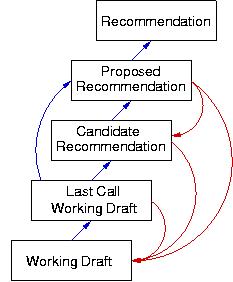
- Getting things started
- working along
- publish working drafts from the working group
- discuss with members and the public
- promote to (candidate/proposed) recommendation (aka standard)
Summary
- could not mention all
- technology makes life easier
- we reach the community (4Mio hits/day on http://www.w3.org/)
- people can access
- fast
- search
- lots of additional information
- because everthing is on the Web
- many tools are available open source
